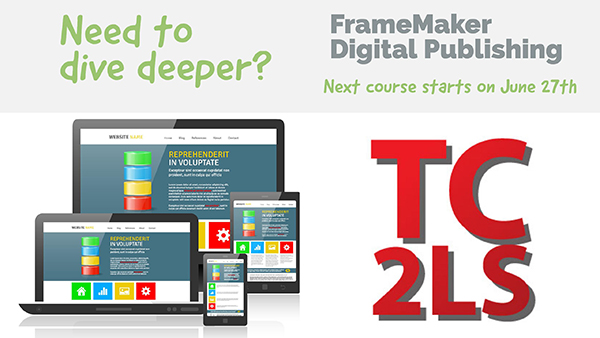
Your FrameMaker 2015 content: There’s an app for that
This is the third in a series of three guest posts by Matt Sullivan, of Tech Comm Tools.
You can find the first two posts at:
Mobilize your content: A FrameMaker Digital Publishing Overview
Easily brand and format digital content with FrameMaker
Mobile apps…what’s in it for me?
Because really, if you have PDF/print, and you already have responsive and other content delivered to your audience, why would you bother with mobile application?
The reason is the same as why you don’t open up a browser every time you need something on your smart phone. Mobile content can take time and data to access, and you might not have internet or cellular access when you need it. Mobile apps download the data once to your phone, and then alert you when the content has been updated. Additionally, mobile apps give your content a permanence and a presence on the mobile device.
So how much extra time are we talking about here?
Inside of FrameMaker 2015 (and RoboHelp 2015, for that matter) there is actually very little you need to do to produce a mobile app. In fact, if you’ve followed the previous two posts regarding outputting and formatting HTML5, you’re truly most of the way there.
Here’s a four minute overview of the process, including the options for installing an Android test app to your device:
However, producing the app is one thing, and getting permission from Apple and Google to upload your great content on their respective App Store and Google Play stores are two entirely different things. But that’s for later…let’s get your content loaded onto an Android device, which is far easier for testing purposes.
At the starting line
For this walkthrough, I’ll be using the same sample files as in the previous two posts. You can find the files at
C:\Program Files (x86)\Adobe\AdobeFrameMaker2015\Samples\UserGuide(Arabic,English,Hebrew)\English\Personal Spaceship User Guide – EN-US.book
With the files open, go to the Publish pod, click on the Change Settings button and choose Edit.
In the Outputs Tab, select the Mobile App output.
General settings
Note that the Manage Layout section lists names that are nearly the same as the Responsive HTML5 layout, but these are not the same formats. You’ll want to take a pass at customizing the format listed here as well.
Application details
Here’s where things get interesting.
Package Name
The default value is an app store convention, so follow form. For my app, the package name would be
com.techcommtools.personalspaceship
Version
The version is the number associated with your iOS app. You can treat it as the version number of your app. I generally set this number independently of the next option, the Version Code.
Version Code (Android*)
Version Code is basically a build number for your app. Thus, you’ll want to use positive whole numbers, and increment this value prior to each build of the app.
Title
The title of your app is what shows on the home screen of the device, below the icon. Be brief, and avoid odd characters in this field.
Description
The description will be attached to the file in your PhoneGap account. Along with being the engine that processes your app, PhoneGap is one of the ways you can download apps to your device.
Icon
This icon image is the graphic that displays above your app title on the mobile device.
Splash Screen
The splash screen is the image displayed when opening your app on the mobile device. The image may distort on various devices, so consider different size options, or creating a 9.png image, which defines scaleable areas to minimize distortion. Note, the image will likely distort in the preview box. You’ll need to process and view on device to determine final image quality.
PhoneGap credentials
FrameMaker relies upon Adobe PhoneGap to process content into a mobile application. You can set up a free PhoneGap account in minutes at http://phonegap.com. Once you have an account, you can enter and validate your user id right here in the dialog box.
Platform
iOS
Setting up an iOS signing key is not a trivial matter. You will first need an Apple Developer account, which is $99 yearly. Once active, you will step through creating a series of credentials for you, your testing devices, and your application for listing on the app store.
While all these things are possible, they do take time and patience. For that reason, in this post we’ll focus on creating and testing an app on an Android device instead.
If you decide to develop an iOS app, I strongly recommend you go to http://training.techcommtools.com to register for my free FrameMaker Digital Publishing course. It will give you a checklist of what you’ll need for iOS app processing and approval, and there’s also a paid version of the course that will help you navigate the process.
Android
For testing purposes, you should not attempt to put any information into the Android signing key setup. Only fill out signing key credentials when you are ready to get content together for Google Play submission.
If you decide to apply for listing on the Google Play app store, you may also want to consider going to http://training.techcommtools.com to register for my free FrameMaker Digital Publishing course. It will give you a checklist of what you’ll need for iOS app processing and approval, and there’s also a paid version of the course that will help you navigate the process.
Processing and installing the test app on Android
Here is a picture of the final settings used to send content to PhoneGap for processing.
Mobile App processing
Once you’ve got all the details filled out, double-click on the Mobile App layout in the Publish pod to begin processing. If everything goes well, you’ll be given the opportunity to view the output, which brings up a dialog to assist in downloading the app to your device. Both the FrameMaker dialog and the PhoneGap web page offer a QR code (to be accessed via an Android device), a download of the file (to transfer the file manually to the device), and a weblink (for tedious data entry in your Android browser!).
My personal favorite is to download the file manually to a shared Dropbox or other file sharing service.
You can also view your app on the PhoneGap Build website at build.phonegap.com. Here is the content, viewed on the PhoneGap site:
Updating the app
Whenever you want to update the content, just change the Version and Version Code numbers and resubmit to PhoneGap. Your file will reprocess, and either the APK download or QR code will transfer the file to your device and ask if you want to replace the previous content.
And just like that, you’re an app developer!
Where to go from here
If you’ve gotten this far, you should pat yourself on the back! Creating digital content and even creating phone apps isn’t the most technical thing in the world, but it does take some patience. Speaking of patience, if you got this far and need to deliver to the app stores, there is a great deal of non-Adobe work to be done.
Be sure to look at my free FrameMaker Digital Publishing course, which will provide a list of the steps you need to take to create the Apple and Google developer credentials for official distribution. There’s also a paid course, if you’re not planning on doing this often, and just need to get it done.
- Post 1: Mobilize your content: A FrameMaker Digital Publishing Overview
- Post 3: Creating iOS and Android apps from your content
- Online course: STC FrameMaker online training course
- Reference book: FrameMaker – Creating and Editing Content
- First section of the book is a free EPUB download
- Available in EPUB or paperback
- Join my email list to get free techcomm, video, and online learning content. I also periodically give away consulting time to list members.
Still want more?
If all you need is a quick fix to your existing system, you can always book a phone or online meeting with me at
https://mattrsullivan.youcanbook.me
It’s the fastest and most direct way to get your problems solved.
About Matt Sullivan
Matt Sullivan is the founder of Tech Comm Tools, and has been helping folks produce better technical communication for almost 20 years. He has trained thousands of people in a dozen Adobe applications, including:
- FrameMaker
- RoboHelp
- Captivate
He specializes in improving workflow and in producing screencasts and other forms of tech comm video. He’s also a big fan of developing online courses because of their potential for depth of training and increased value to the student.
Matt helps organizations produce better content, including video and multimedia, and deliver it digitally to a web and mobile audience.
Join Matt’s email list to be the first to see a series of 25 videos highlighting Technical Communication Suite integration features. Sponsored by Adobe, the series is being billed as Getting Started with Technical Communication Suite and will serve as in introductory course to available TCS integration options.

Join over 4,300 of your peers and get my latest content sent to you for free, along with some of my all-time favorites.






